1965 CHEVROLET CORVAIR ECO mode
[x] Cancel search: ECO modePage 5 of 56
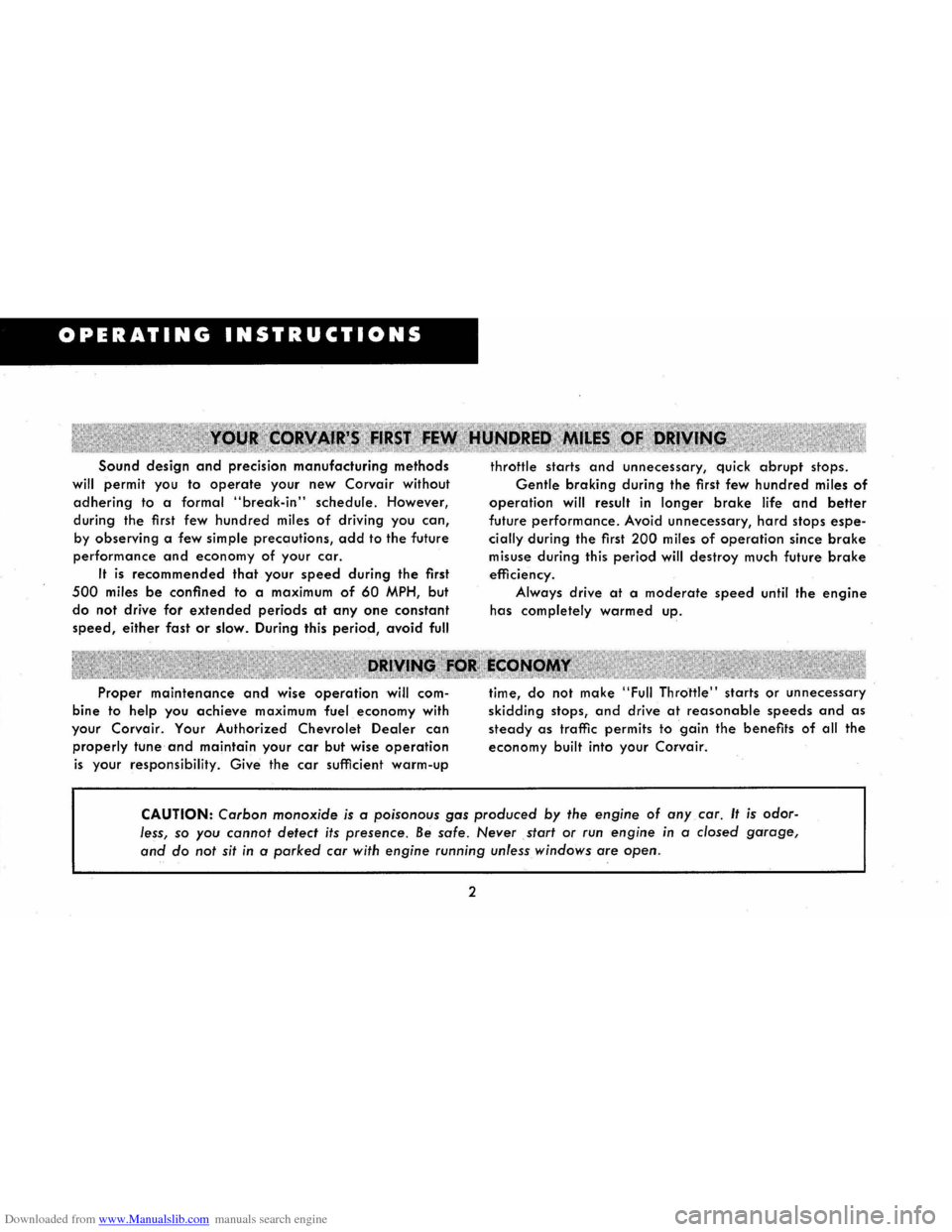
Downloaded from www.Manualslib.com manuals search engine OPERATING INSTRUCTIONS
Sound design and precIsion manufacturing methods
will permit you to operate your new Corvair without
adhering to a formal "break-in" schedule. However,
during the first few hundred miles of driving you can,
by observing a few simple precautions, add to the future
performance and economy of your car.
It is recommended that your speed during the first
500 miles be confined to a maximum of 60 MPH, but
do not drive for extended periods at anyone constant
speed, either fast or slow. During this period, avoid full
Proper maintenance and wise operation will com
bine to help you achieve maximum fuel economy with
your Corvair. Your Authorized Chevrolet Dealer can
properly tune and maintain your car but wise operation
is your responsibility. Give the car sufficient warm-up
throttle starts and unnecessary, quick abrupt stops.
Gentle braking during the first few hundred miles of
operation will result in longer brake life and better
future performance. Avoid unnecessary, hard stops espe
cially during the first 200 miles of operation since brake
misuse during this period will destroy much future brake
efficiency.
Always drive at a moderate speed until the engine
has completely warmed up.
time, do not make "Full Throttle" starts or unnecessary
skidding stops, and drive at reasonable speeds and as
steady as traffic permits to gain the benefits of all the
economy built into your Corvair.
CAUTION: Carbon monoxide is a poisonous gas produced by the engine of any car. It is odor
less,
so you cannot detect its presence. Be safe. Never start or run engine in a closed garage,
and do not sit in a parked car with engine running unless windows are open.
2
Page 22 of 56
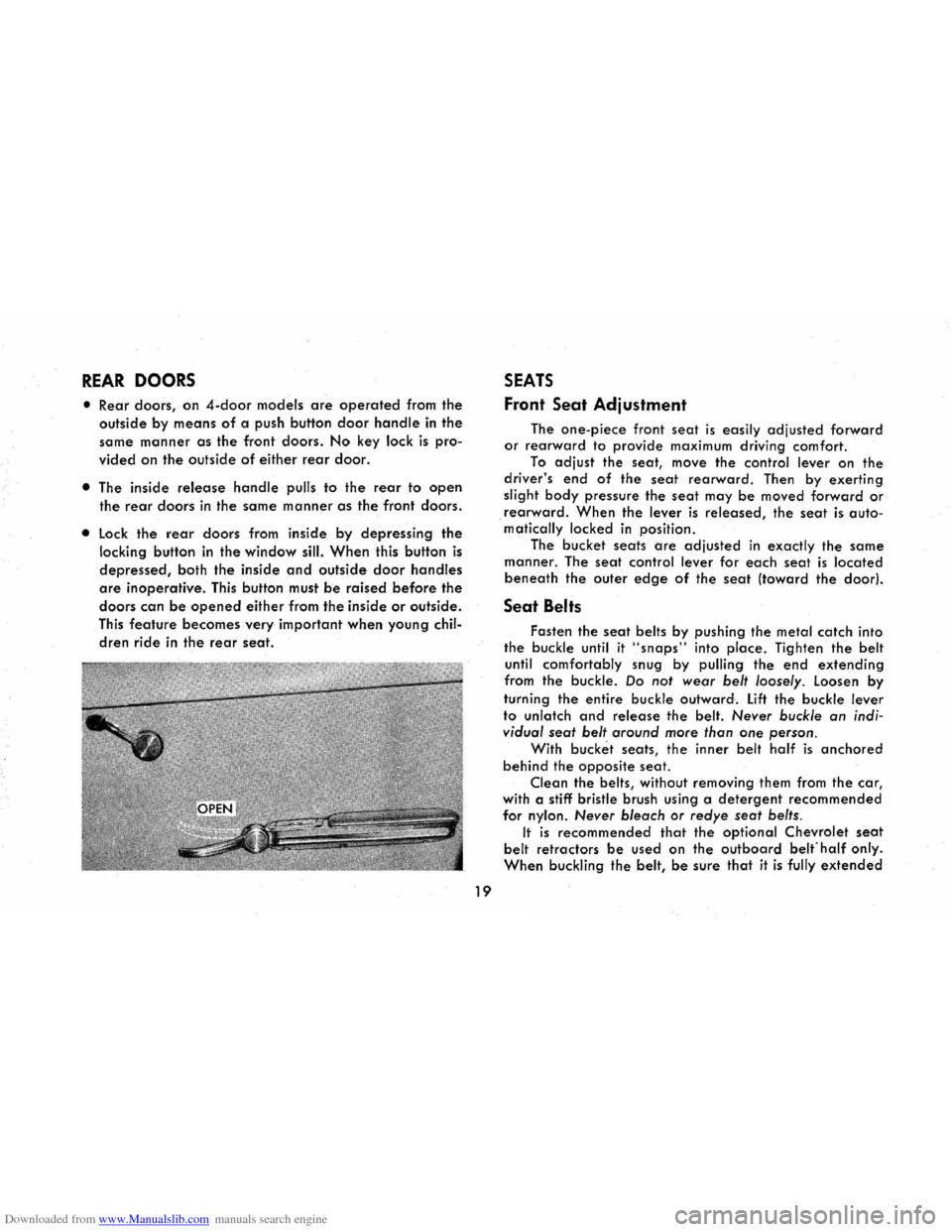
Downloaded from www.Manualslib.com manuals search engine REAR DOORS
• Rear doors, on 4-door models are operated from the
outside by means of a push button door handle in the
same
manner as the front doors. No key lock is pro
vided On the outside of either rear door.
• The inside release handle pulls to the rear to open
the rear doors in the same manner as the front doors.
• lock the rear doors from inside by depressing the
locking button in the window sill. When this button is
depressed ,
both the inside and outside door handles
are inoperative. This button must be raised before the
doors can be opened either from the inside or outside.
This
feature becomes very important when young chil
dren ride in the rear seat.
19
SEATS
Front Seat Adjustment
The one-piece front seat is easily adjusted forward or rearward to provide maximum driving comfort.
To adjust the seat, move the control lever on the
driver's end of the seat rearward. Then by exerting
slight body pressure the seat may be moved forward or
rearward. When the lever is released, the seat is auto. matically locked in position.
The
bucket seats are adjusted in exactly the same
manner. The seat control lever for each seat is located
beneath the outer edge of the seat (toward the door).
Seat Belts
Fasten the seat belts by pushing the metal catch into
the buckle until it "snaps" into place, Tighten the belt
until comfortably snug by pulling the end extending
from the buckle. Do not wear belt loosely . loosen by
turning the entire buckle outward. lift the buckle lever
to unlatch and release the belt. Never buckle an indi
vidual seat belt around more than
one person .
With bucket seats, the inner belt half is anchored
behind the opposite seat.
Clean the belts, without removing them from the car,
with a stiff bristle brush using a detergent recommended
for nylon. Never bleach or redye seat belts .
It is recommended that the optional Chevrolet seat
belt retractors be used on the outboard belfhalf only.
When buckling the belt, be sure that it is fully extended
Page 25 of 56
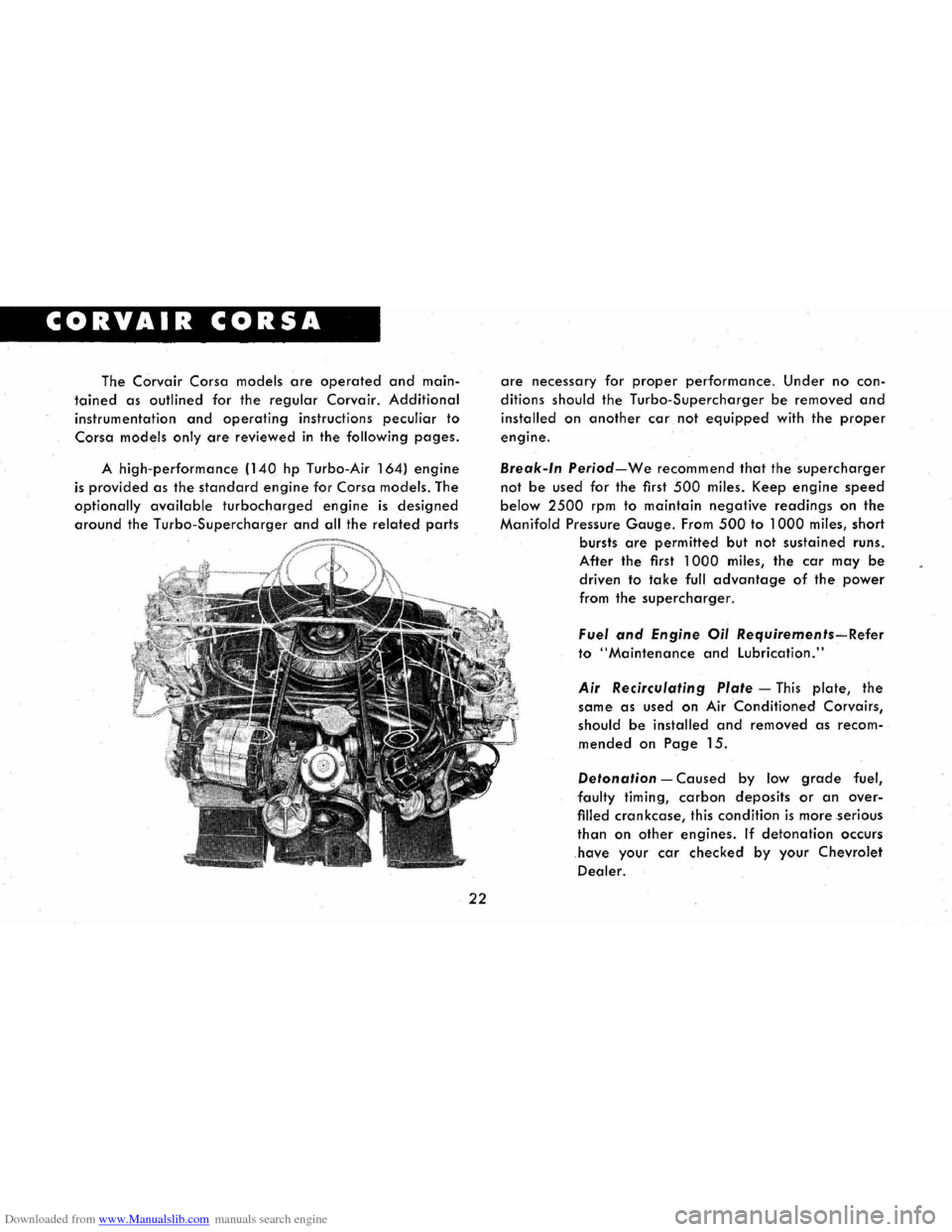
Downloaded from www.Manualslib.com manuals search engine CORVAIR CORSA
The Corvair Corsa models are operated and main
tained as outlined for the regular Corvair. Additional
instrumentation and operating instructions peculiar to
Corsa models only are reviewed in the following pages.
A high-performance (140 hp Turbo-Air 164) engine
is provided as the standard engine for Corsa models. The
optionally available turbocharged engine is designed
around the Turbo-Supercharger and all the related parts
22
are necessary for proper performance. Under no con
ditions should the Turbo-Supercharger be removed and
installed on another car not equipped with the proper
engine.
Break-In Period-We recommend that the supercharger
not be used for the first 500 miles. Keep engine speed
below 2500 rpm to maintain negative readings on the
Manifold Pressure Gauge. From 500 to 1000 miles, short
bursts
are permitted but not sustained runs.
After the first 1000 miles, the car may be
driven to take full advantage of the power
from the supercharger.
Fuel and Engine Oil Requirements~Refer
to "Maintenance and Lubrication."
Air Recirculating Plate -This plate, the
same as used on
Air Conditioned Corvairs,
should be installed and removed as recom
mended on Page 15.
Detonation -Caused by low grade fuel,
faulty timing, carbon deposits or an over
filled crankcase, this condition is more serious
than on other engines. If detonation occurs
have your car checked by your Chevrolet
Dealer.
Page 34 of 56
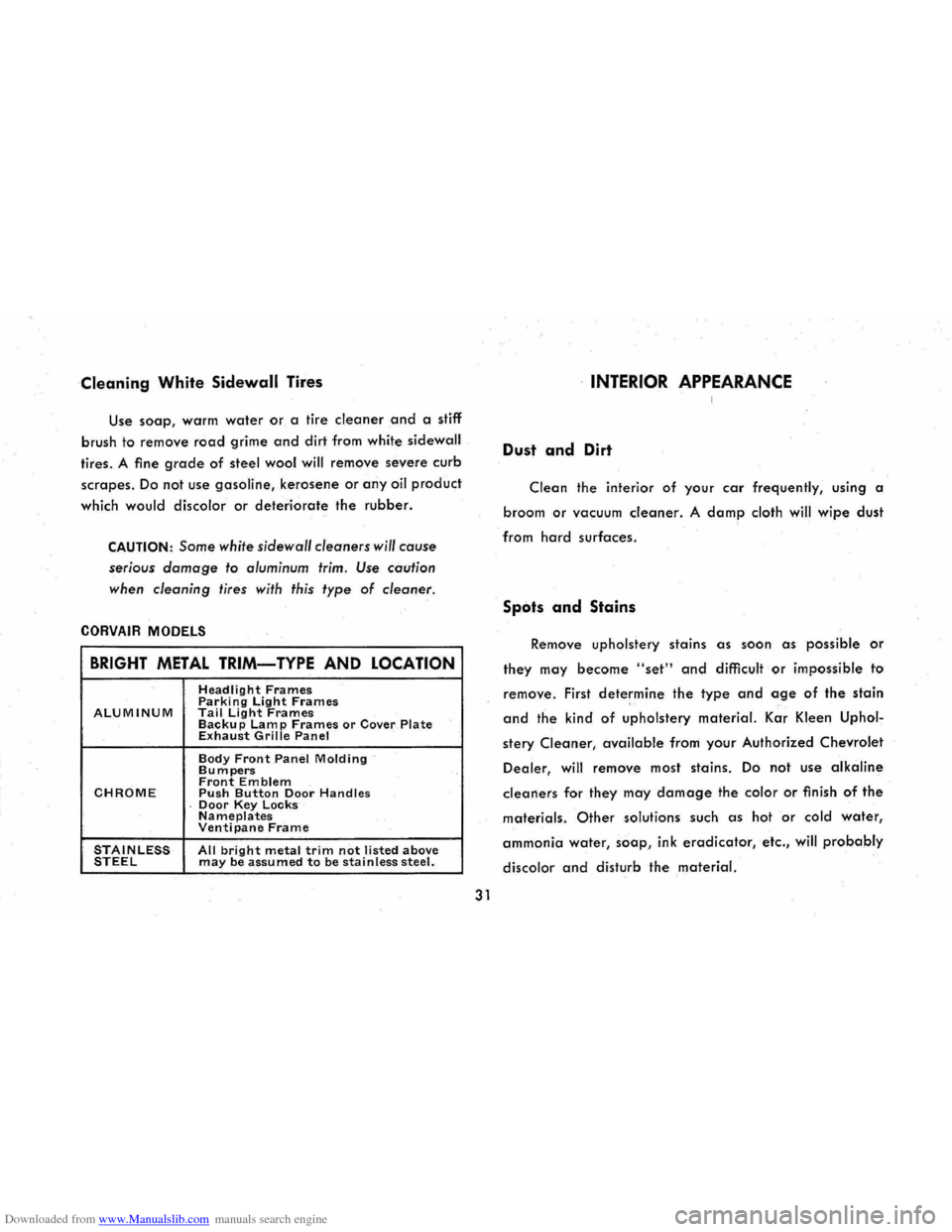
Downloaded from www.Manualslib.com manuals search engine Cleaning White Sidewall Tires
Use soap, warm water or a tire cleaner and a stiff
brush
to remove road grime and dirt from white sidewall
tires. A flne grade of steel wool will remove severe curb
scrapes.
Do not use gasoline, kerosene or any oil product
which would discolor or deteriorate the rubber.
CAUTION: Some white sidewall cleaners will cause
serious
damage to aluminum trim. Use caution
when cleaning tires with this
type of cleaner.
CORVAIR MODELS
BRIGHT METAL TRIM-TYPE AND LOCATION
Headlight Frames Parking light Frames ALUMINUM Tail light Frames Backup Lamp Frames or Cover Plate Exhaust Grille Panel
Body Front .Panel Molding Bumpers Front Emblem CHROME Push Button Door Handles Door Key Locks Nameplates Venti pane Frame
STAINLESS All bright metal trim not listed above STEEL may be assumed to be stainless steel.
31
INTERIOR APPEARANCE
Dust and Dirt
Clean the interior of your car frequently, using a
broom or vacuum cleaner. A damp cloth will wipe dust
from hard surfaces.
Spots and Stains
Remove upholstery stains as soon as possible or
they may become "set" and difficult or impossible to
remove . First determine the type and age of the stain
and the kind of upholstery material. Kar Kleen Uphol
stery Cleaner, available from your Authorized Chevrolet
Dealer, will remove most stains. Do not use alkaline
cleaners for they may damage the color or flnish of the
materials. Other solutions such as hot or cold water,
ammonia water, soap, ink eradicator, etc., will probably
discolor and disturb the material.
Page 36 of 56
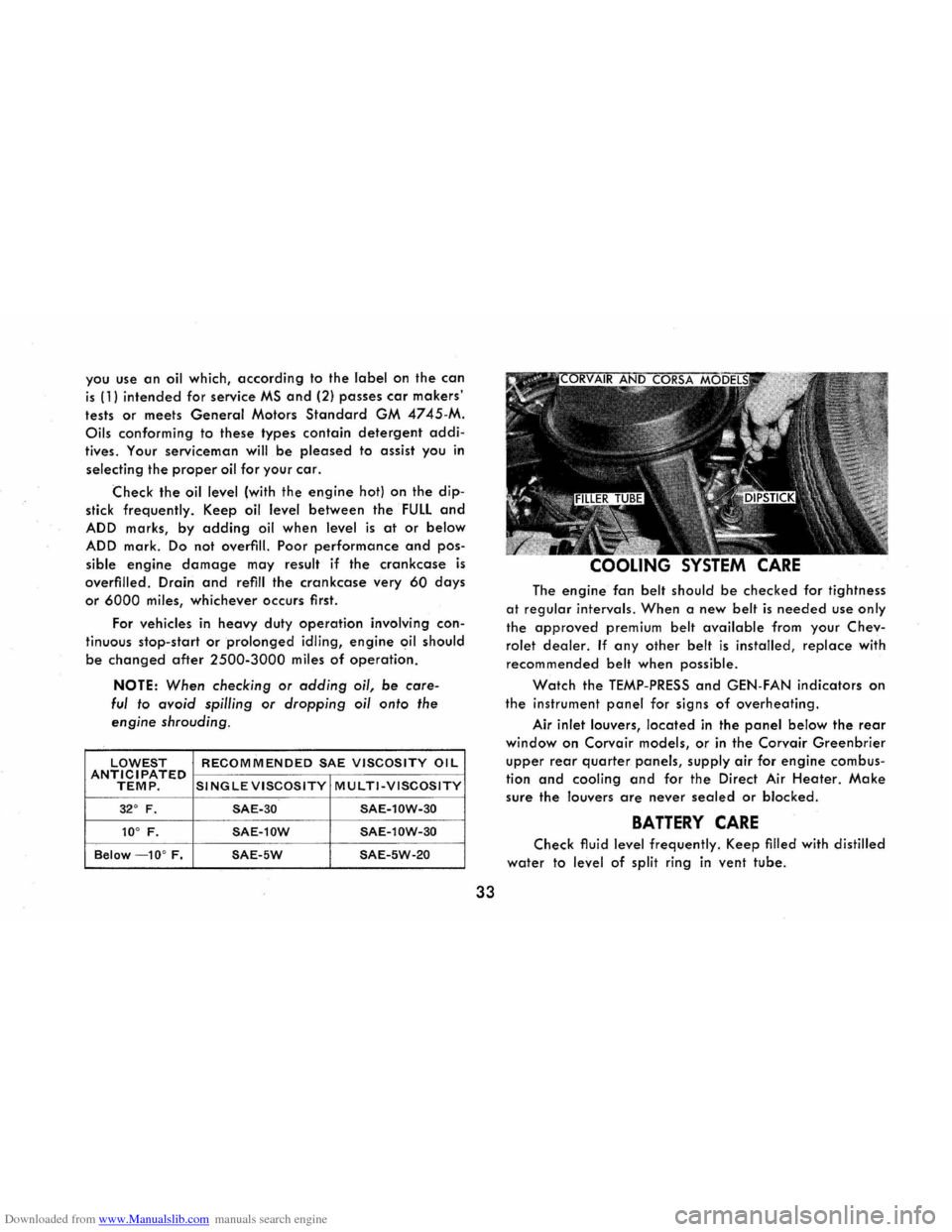
Downloaded from www.Manualslib.com manuals search engine you use an oil which, according to the label on the can
is (1) intended for service MS and (2) passes car makers'
tests or meets General Motors Standard GM 4745-M .
Oils conforming to these types contain detergent addi
tives. Your serviceman will be pleased to assist you in
selecting the proper oil for your car.
Check the oil level (with the engine hot) on the dip
stick frequently. Keep oil level between the FULL and
ADD marks, by adding oil when level is at or below
ADD mark. Do not overfill. Poor performance and pos
sible engine damage may result if the crankcase is
overfilled. Drain and refill the crankcase very 60 days
or 6000 miles, whichever occurs first.
For vehicles
in heavy duty operation involving con
tinuous stop-
start or prolonged idling, engine oil should
be changed after 2500-3000 miles of operation.
NOTE: When checking or adding oil, be care
ful to avoid spilling or dropping oil onto the
engine shrouding.
LOWEST RECOMMENDED SAE VISCOSITY OIL ANTICIPATED TEMP. SINGLE VISCOSITY MULTI-VISCOSITY
32° F. SAE-30 SAE-l0W-30
10° F. SAE-l0W SAE-l0W-30
Below -10° F. SAE-5W SAE-5W-20
33
COOLING SYSTEM CARE
The engine fan belt should be checked for tightness
at regular intervals. When a new belt is needed use only
the approved premium belt available from your Chev
rolet dealer. If any other belt is installed, replace with
recommended belt when possible .
Watch the TEMP-PRESS and GEN-FAN indicators on
the instrument panel for signs of overheating.
Air inlet louvers, located in the panel below the rear
window on Corvair models, or in the Corvair Greenbrier
upper rear quarter panels, supply air for engine combus
tion
and cooling and for the Direct Air Heater. Make
sure the louvers are never sealed or blocked.
BATTERY CARE
Check fluid level frequently. Keep filled with distilled
water to level of split ring in vent tube.
Page 37 of 56
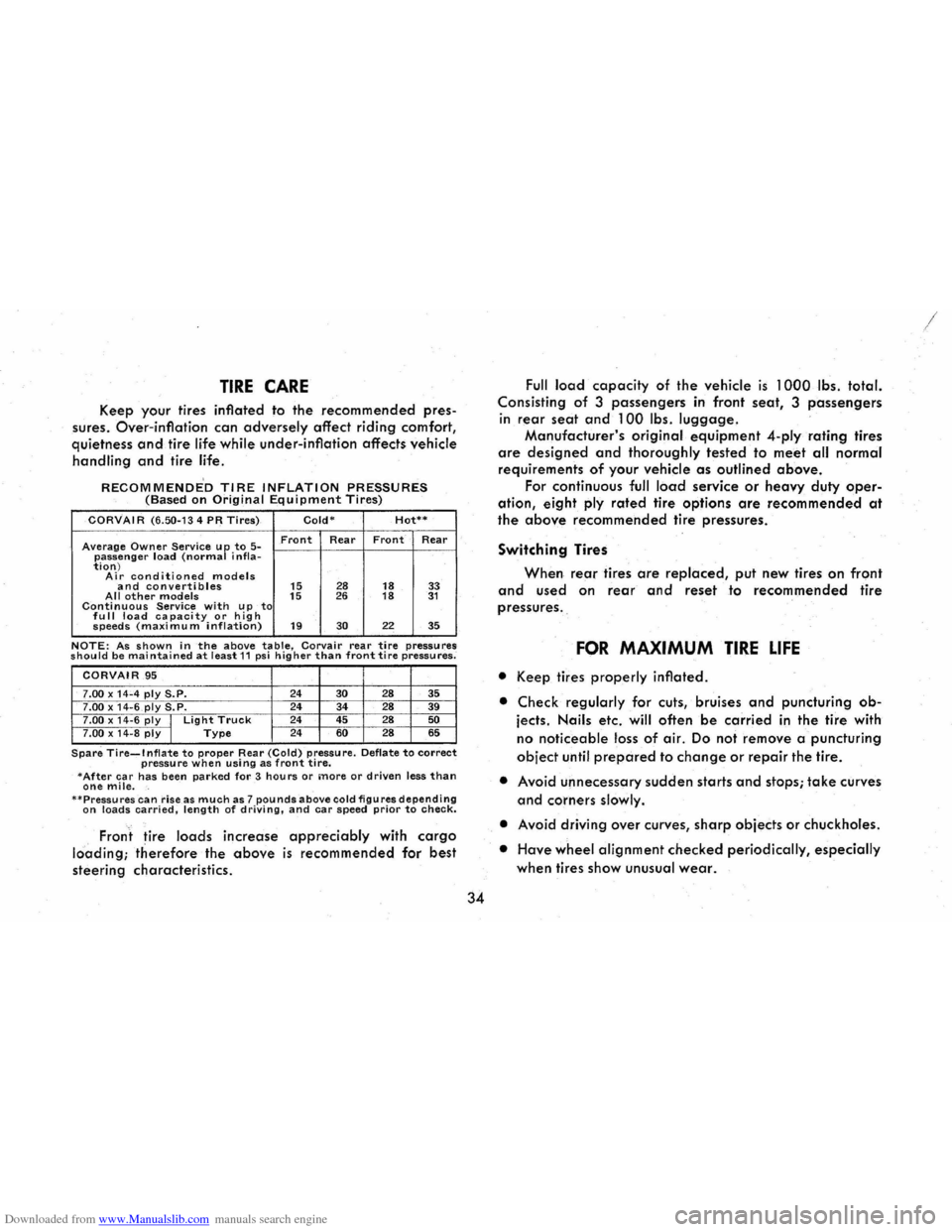
Downloaded from www.Manualslib.com manuals search engine TIRE CARE
Keep your tires inflated to the recommended pres
sures.
Over-inflation can adversely affect riding comfort,
quietness and tire life while under-inflation affects vehicle
handling and tire life.
RECOMMENDED TIRE INFLATION PRESSURES (Based on Original Equipment Tires)
CORVAIR (6.50-134 PR Tires) Cold-Hot**
Average Owner Service up to 5-Front Rear Front Rear
passenger load (normal i nfla-tion) Air conditioned models and convertibles 15 28 18 33 All other models 15 26 18 31 Continuous Service with up to fu II load ca pacity or h ig h speeds (maximu m inflation) 19 30 22 35
NOTE: As shown in the above table, Corvair rear tire pressures should be maintained at least 11 psi higher than front tire pressures;
CORVAIR .95
7.00 x 14"4 ply S.P. 24 30 28 35 7.00 x 14-6 ply S.P. 24
34 28 39 7.00 x 14-6 ply I Light Truck 24
45 28 50
7 .00 x 14 -8 ply I Type 24 60 28 65
Spare Tire...,.lnflate to proper Rear (Cold) pressure. Deflate to correct pressure when using as front tire. -After car has been parked for 3 hours or more or driven less than one mile. --Pressures can riseas much as 7 pounds above cold figures depending on loads carried, length of driving, and car speed prior to check.
, Fron t tire loads increase appreciably with cargo
lci'ading; therefore the above is recommended for best
steering characteristics.
34
Full load capacity of the vehicle is 1 OOOlbs. total.
Consisting of 3 passengers in front seat, 3 passengers
in
rear seat and 100 Ibs . luggage.
Manufacturer's original equipment 4-plyrating tires
are designed and thoroughly tested to meet all normal
requirements of your vehicle as outlined above.
For continuous full load service or heavy duty oper
ation, eight ply rated tire options are recommended at
the above recommended tire pressures.
Switching Tires
When rear tires are replaced, put new tires on front
and used on rear and reset to recommended tire
pressures. ,
FOR MAXIMUM TIRE LIFE
• Ke.ep tires properly inflated.
• Check regularly for cuts, bruises and puncturing ob
jects. Nails etc. will often be carried in the tire with
no noticeable loss of air. Do not remove a puncturing
object until prepared to change or repair the tire.
• Avoid unnecessary sudden starts and stops; take curves
and corners slowly.
•
Avoid driving over curves, sharp objects or chuckholes.
•
Have wheel alignment checked periodically, especially
when tires show unusual wear.
Page 40 of 56
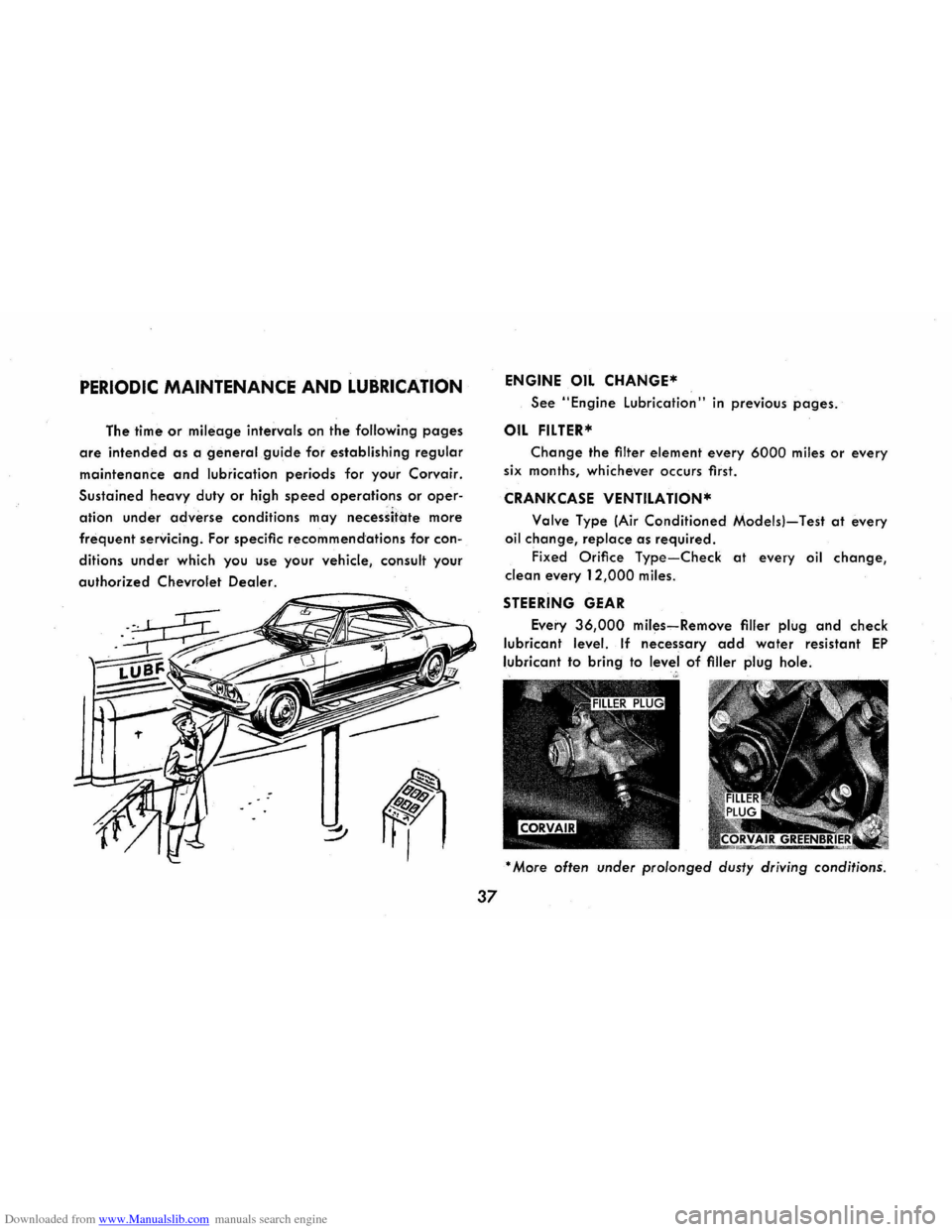
Downloaded from www.Manualslib.com manuals search engine PERIODIC MAINTENANCE AND LUBRICATION
The time or mileage intervals on the following pages
are intended as a general guide for establishing regular
maintenance and lubrication periods for your Corvair.
Sustained heavy duty or high speed operations or oper
ation under adverse conditions may necessitate more
frequent servicing. For specific recommendations for con
ditions under which you use your vehicle, consult your
authorized Chevrolet Dealer.
37
ENGINE OIL CHANGE*
See "Engine Lubrication" in previous pages.
OIL FILTER*
Change the filter element every 6000 miles or every
six months, whichever occurs first.
CRANKCASE VENTILA T10N*
Valve Type (Air Conditioned Models)-Test at every
oil change, replace as required.
Fixed Orifice Type-Check at every oil change,
clean every
12,000 miles.
STEERING GEAR
Every 36,000 miles-Remove filler plug and check
lubricant level. If necessary add water resistant EP
lubricant to bring to level of filler plug hole.
* More often under prolonged dusty driving conditions.